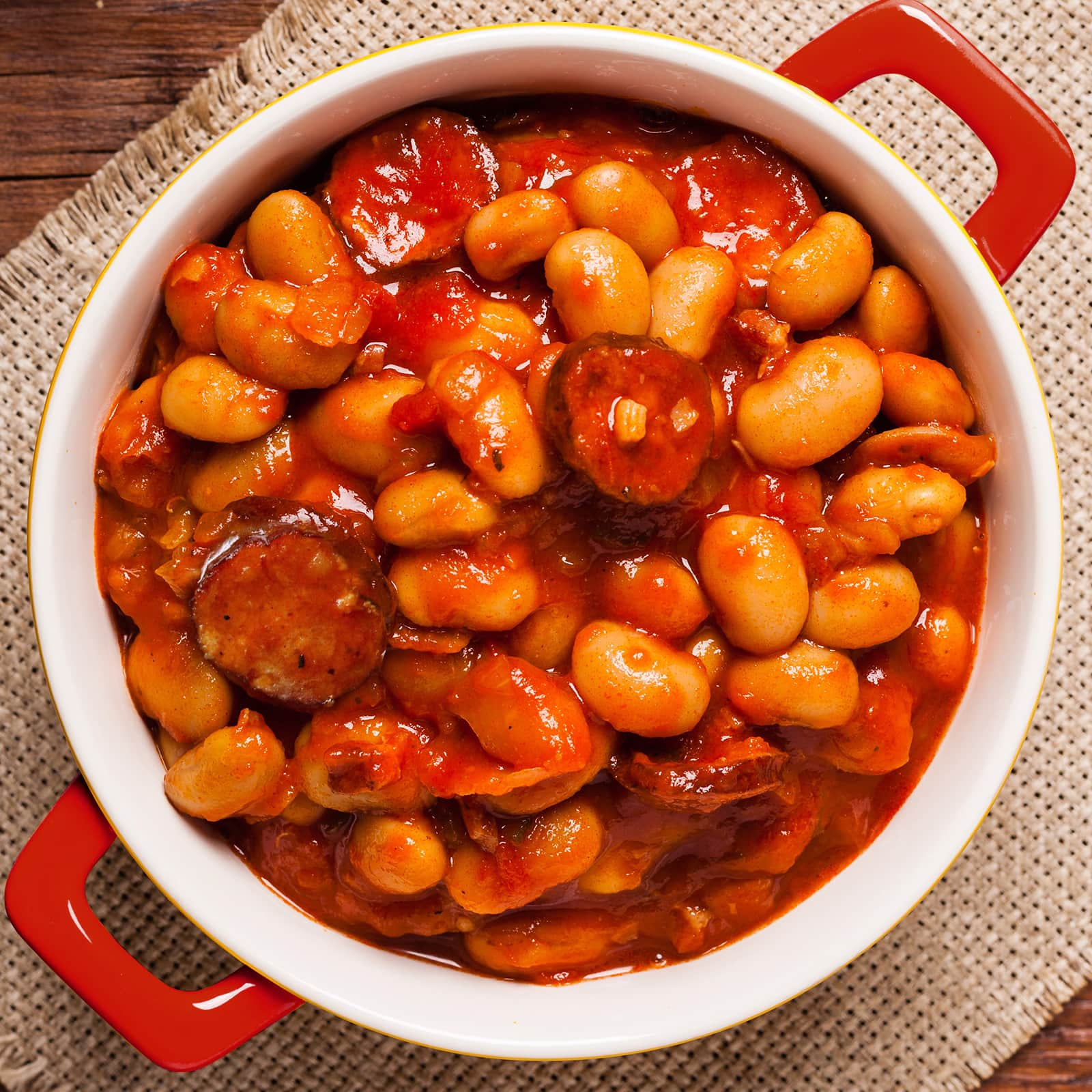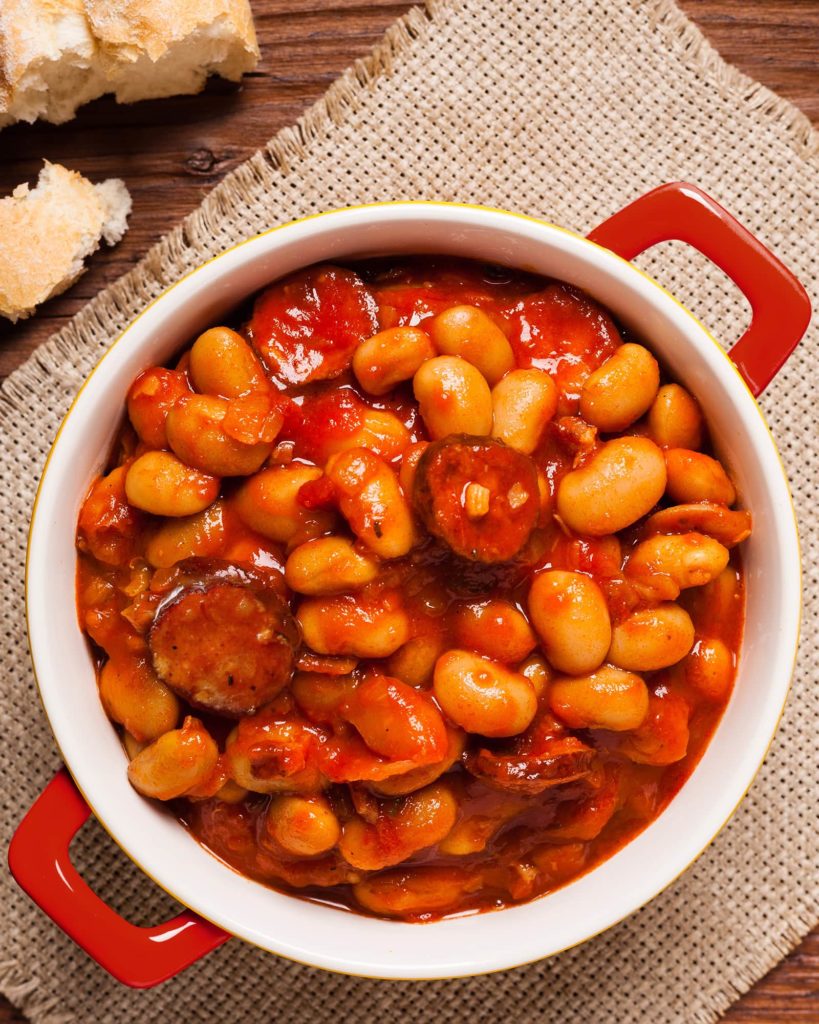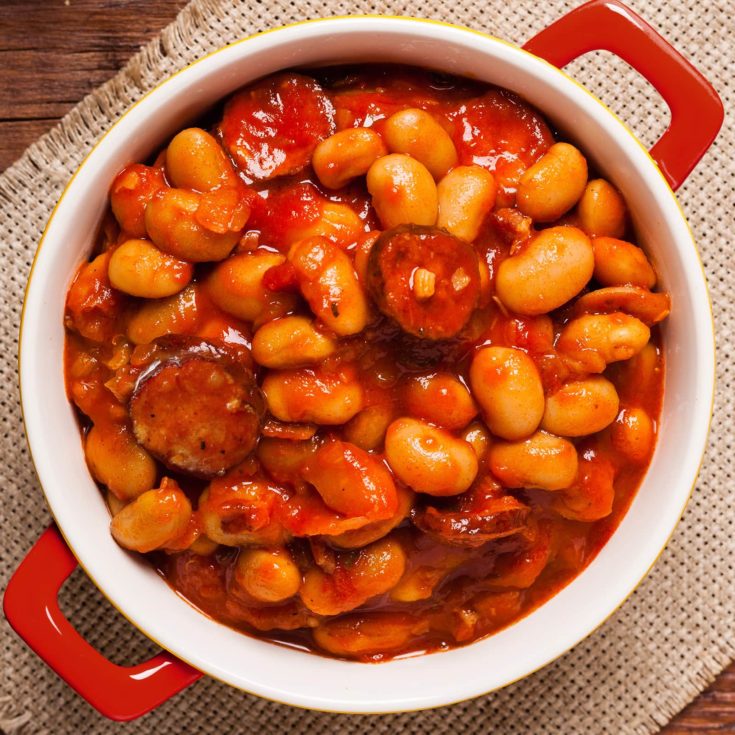Fasolka po bretońsku
Fasolka po bretońsku: White Baked Beans with Kiełbasa
How to pronounce it?
fasolkah pobre-toñskoo
‘Play’ to hear:

Fasolka po bretońsku is a humble slow-simmered stew of white beans, tomatoes and various types of meat, most typically kiełbasa and bacon. While cooking slowly, beans and smoky meats mingle together and transform into a pot of lush, velvety richness.
When reheated, Fasolka po bretońsku tastes even better – making it an excellent option for social gatherings (or any batch-cooking in general).
For the full list of ingredients & detailed instructions, please see the recipe card at the end of this post. But before you scroll, there’s important stuff to know below.
Fasolka po bretońsku (Polish for: ‘Beans à la Brittany’ or ‘Breton Beans’) doesn’t have a long history. Its popularity peaked during the communist times, and has remained a staple to this day.
Fasolka po bretońsku was likely inspired by the Provençal Cassoulet, a slow-cooked casserole made with meat and beans. In the version from Brittany, pork was the protein of choice in this dish. (source)
During World War I, this French dish rose in popularity among troops. After all, it was a perfect army dish: one-pot, cheap, easy, nutritious, and… delicious. No wonder the recipe spread quickly and soon became well-loved in nearly every Polish home.
Fasolka po bretońsku doesn’t appear often (if at all…) on restaurant menus. Sometimes you’ll find it in canteens, or the last remaining milk bars. But if you venture out to a supermarket, you’ll find that ‘Fasolka po bretońsku’ is sold in cans and jars, as a convenient ready meal. It’s a perfect provision for hiking or camping trips.
Do you need any special ingredients or equipment?
No, most of the ingredients for this recipe should be easily available in any major supermarket.
White Beans
In Poland, the most commonly used bean for this recipe is ‘Piękny Jaś’, which translates literally to (I kid you not!) ‘Beautiful Johnny’. It’s a regional bean variety from Lesser Poland, specifically the area of Dolina Dunajca (Dunajec River Gorge).
Internationally, there are many substitutes, such as Butter/Lima, Cannellini, Navy, Great Northern or White Emergo (sweet white Runner Bean). Please note, that some types of beans cook quicker than others – follow the instructions from the label.
Kiełbasa
The recipe calls for 2 short links (roughly 9 oz, 250 g) of high-quality kiełbasa.
Be mindful that in Poland, kiełbasa is a very broad term for all sausages. Therefore more specifically, look out for kiełbasa ‘wiejska’ or ‘zwyczajna’ (‘podwawelska’ or ‘śląska’ are good choices as well).
Dried Savory
Savory (‘cząber’ in Polish) is not a very common herb, but it’s worth having it in your pantry. If you can’t find it in your local grocery store, it’s available online.
Alternatively, replace it with dried thyme, additional marjoram – or skip it altogether.
Equipment-wise, all you really need is:
- sharp knife
- skillet/frying pan
- large-ish cooking pot
What to serve it with?
Fasolka po bretońsku is typically enjoyed for dinner, supper, or at large events, such as concerts and festivals. It’s very nutritious and filling, and therefore is treated as a stand-alone meal.
Fasolka po bretońsku is most commonly served with a few slices of bread, but on occasion, I’ve seen it alongside cooked rice, buckwheat groats or mashed potatoes.
Can you cook it another way?
In this recipe, you’ll find two ways of preparing this dish – either with dried, or canned beans.
If you would like to enrich this meal further (and make it lighter and healthier), you can add more ingredients, such as:
- bell peppers
- carrots
- zucchini/courgettes
- button mushrooms
Drink-wise, a glass of cold water seems to be the best choice. In terms of spirits, Fasolka po bretońsku pairs well with lighter, younger red wines, such as Beaujolais (source in Polish).
What diets is it suitable for?
This recipe is suitable for a traditional diet.
In general, Fasolka po bretońsku should also be gluten-free and dairy-free, but please double-check the labels of the individual ingredients, especially bacon and kiełbasa.
How long can you keep it in the fridge?
Once served, don’t keep it out for longer than 3-4 hours.
To store any leftovers, move them into a container with a lid (jars work well here) and refrigerate for up to 3-4 days. If you plan to store Fasolka for longer periods of time, either freeze it or tyndallize it (triple-pasteurize) in jars.
Can I freeze it?
Yes, Fasolka po bretońsku can be frozen.
Make sure it cools down completely and then move it over into a freezer-friendly zip-bag or a container with a lid. Label it with a description and the date, and aim to consume within 3 months.
How do I reheat it?
From chilled
Anecdotally, Fasolka po bretońsku tastes even better after reheating. Warm it up on the stove, stirring occasionally, until hot throughout. If the sauce became too thick, water it down a little (with water, unsalted stock or broth).
If you own a microwave, move Fasolka into a microwave-friendly container with a loosely fitting lid. Heat for 3 to 4 minutes until piping hot, stirring halfway through.
From frozen
Allow to defrost completely, then proceed as above.

Recipe: step by step
Fasolka po bretońsku (aka 'Breton Beans'): Polish-style White Beans with Kiełbasa and Bacon

Ingredients
- 14 oz (0.9 lb; 400 g) dry large butter/lima beans; can be replaced with 2 cans (16 oz; 400-450 g each); more details in the post above
- 2 dried bay leaves
- 3-4 allspice berries
- 7 oz (200 g) smoked bacon slab
- 9 oz (250 g) smoked kiełbasa
- 1 medium onion (4 oz; 120 g), white or yellow
- 3 large garlic cloves
- 1 tablespoon lard, can be replaced with neutral cooking oil
- 3 tablespoons tomato paste (tomato concentrate)
- 0.5 teaspoon smoked paprika powder
- 0.5 teaspoon spicy paprika powder; optional
- 0.5 cup (120-125 ml) dry red wine; can be replaced with stock or skipped completely
- 14 oz (400 g) canned diced tomatoes in tomato juice
- 1 teaspoon dried savory; can be replaced with dried thyme or 1 sprig of fresh savory/thyme
- 2 tablespoons dried marjoram
- salt; for seasoning
- black pepper, ground; for seasoning
- 1 tablespoon fresh parsley, chopped; for garnish
Instructions
Soaking & cooking dried beans
[the night before, skip if using canned beans]
- Rinse the beans well. Place them in a cooking pot.
- Pour cold water in, around 4 inches (10 cm) above the beans. Set aside to soak overnight.
- Strain the next day and pour 4 cups (approx. 1 litre) of fresh water in. Add 2 bay leaves, 3-4 allspice berries and 1 teaspoon of salt. Bring to a boil, then reduce the heat.
- Cover with a lid (leaving a tiny gap) and gently simmer for around 90 minutes. Check the water level from time to time - if it’s getting too low, pour more in. Not sure if your beans are cooked? Do a quick taste test. Beans should be tender, yet still firm.
Prep work
- [Optional step] Place the slab of bacon into the freezer for 15-20 minutes, allowing it to firm up.
- Retrieve the slab bacon from the freezer. Using a sharp knife, cut the skin off the bacon slab. You can add it whole to the cooking beans, for flavour (you’ll have to fish it out later). Otherwise - just discard it.
- Dice the bacon into cubes. The size is up to you, I prefer smaller cubes, roughly sized at 0.2-0.3’’ (5-7 mm) per side. Set aside.
- Slice kiełbasa into rounds. Again, their thickness is up to you - but in general, the better kiełbasa quality, the thicker the rounds can be. Alternatively, you can dice kiełbasa into cubes. Set aside.
- Peel the onion and garlic cloves. Dice the onion finely; then chop or mince the garlic. Set aside.
Frying
- In a deep skillet/frying pan, heat up a tablespoon of lard or cooking oil. Add in diced bacon first and fry, stirring occasionally. Once it gains some colour, add kiełbasa rounds and fry together until golden.
- Add diced onion and three tablespoons of tomato concentrate. Season with half a teaspoon of smoked paprika powders, and half a teaspoon of spicy paprika powder, if you enjoy more ‘kick’. Stir to combine and fry gently until the onion starts to turn translucent (5 minutes or so).
- Add chopped garlic, stir it in and continue frying for 2 minutes. Pour half a cup of dry red wine and combine.
- [Using beans cooked from scratch] Move the contents of the skillet/frying pan into the pot with cooked beans. If there’s still some water there - that’s okay, there’s no need to strain it.
- [Using canned beans] Add canned beans into the skillet/frying pan, together with the bean liquid.
- Add diced tomatoes and season with a teaspoon of dried savory, two tablespoons of marjoram and a generous pinch of salt and ground black pepper. Stir and cover partially with a lid. Simmer on medium-low for 15 minutes, allowing the flavours to combine.
Finishing touches
- Have a taste. If it’s too acidic (sometimes that happens, when the tomatoes are too acidic), add a teaspoon of sugar and stir it in.
- If the consistency of your 'Fasolka po Bretońsku' is too watery, there are two remedies:
- Continue cooking without a lid, allowing the excess liquid to evaporate, or...
- Move some of the sauce into a cup, and a tablespoon of all-purpose flour, blend together with a fork (into a smooth paste) and return to the pot. - Garnish with chopped parsley and serve immediately in soup plates or bowls, with freshly sliced bread on the side.
Nutrition Information:
Yield:
6Serving Size:
1Amount Per Serving: Calories: 515Total Fat: 38gSaturated Fat: 20gTrans Fat: 1gUnsaturated Fat: 15gCholesterol: 88mgSodium: 1341mgCarbohydrates: 34gFiber: 13gSugar: 17gProtein: 13g
Polonist is reader-supported. When you buy through links on our site, we may earn a small affiliate commission. Learn more
Recipe Information
Filed under:
Alternative traditional/regional names:
Also known / Misspelt internationally as:
Polish Beans, Polish Butter Bean Soup, Kiełbasa Bean Soup, Kiełbasa and Beans, Polish Breton Beans
Tested by:
First published on:
Recipe by / Adapted from:
Story by:
Bibliography / References:
1. “Sto Receptur Na Sto Lat Niepodległości 1918-2018” (“One Hundred Recipes for One Hundred Years of Independence 1918-2018”) ISBN 978-83-952306-0-8, Published by Makro Cash and Carry Polska S.A.; page 242